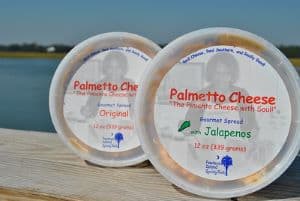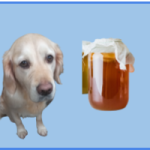
Pimento- a catchy name for peppers, don’t you think?
And for detectives in Brooklyn Nine Nine but that is going off topic a bit?!
Pimento peppers come in all shapes, sizes, and striking colors you can see during those strolls around the grocery aisles.
This ingredient is quite infamously found in pimento cheese.
It comprises cheese (obviously), creamy mayonnaise, and, you guessed it, pimentos!
We’re pretty sure you and your furry friend are both salivating after reading this (because we are too!)
With that being said, we’ll be going through everything you need to know about pimento cheese and facts to consider before you give a chunk to your beloved dogs.
So, whenever you’re ready, let’s skedaddle right to it!
And let me start with the basics.
Can Dogs Eat Pimento Cheese?
In short, the answer to that question is yes!
When they say sharing is caring, they also mean both sides can safely enjoy whatever is being shared, which appears to be the case for pimento cheese.
But please be mindful of feeding pimento cheese in moderation and always watching out for the ingredients list.
As long as you opt for ones with low sodium and fat content, feeding them to your beloved pal in moderate amounts is undoubtedly a green light.
What nutrition could pimento cheese provide to a dog?
Apart from its punch-packing and extravagant taste, pimento cheese unsurprisingly offers some decent nutritional value for your furry besties!
As a start, pimento cheese has zero (yes zero, we tell you) sugar and is packed with essential minerals such as Calcium (for sturdy and strong bones) and sodium (necessary for proper cell functions).
We’re also pleased to inform you that pimento cheese is low in carbs (2 g), and a decent punch of protein (5 g) per portion size, and, best of all, a low-calorie count of 110; per portion!
However, fat and sodium levels are pretty high at 9 g and 210 mg, respectively (*cries in disappointment*).
So, you may want to consider the portion sizes before you feed your canines this scrumptiously melting treat.
Are any of the ingredients in pimento cheese toxic?
No matter how tempting it may be for your furry pal to devour an entire bowl, some ingredients may compromise your dog’s health.
As mentioned, pimento cheese is mainly made up of cheese, mayonnaise, and pimentos, all of which are not toxic (thank goodness).
However, depending on the recipe or brand, some pimento cheese may contain seasonings such as onion and garlic powder, which are toxic to dogs.
Consumption of onion or garlic powder may eventually lead to anemia in dogs.
It contains a toxic compound known as N-propyl disulfide (aka the culprit that breaks down red blood cells).
As the responsible dog owner as you are, please, please keep their furry little paws as far away from this as possible, even if they get upset or googly about it (we know it can be challenging, but you got this!)
After all, it’s for their health and goodness sake.
Note: If your pet accidentally consumed large amounts of garlic or onion, immediately rush them to the nearest vet for some emergency treatment!
Even if the ingredients aren’t toxic, how might they affect a dog?
Though these main ingredients are non-toxic to dogs, you might still need to weigh in on just how much is safe for your furry pals to eat without compromising their health in any way?
Here are some things you should take note of:
Pimentos
Even though most peppers contain high levels of capsaicin (tricky pronunciation, we know), pimentos, fortunately, have super low capsaicin levels.
Capsaicin is typically found in pepper seeds and ribs, and high levels of this compound are an absolute no-no when it comes to your furry friend’s digestive tract.
Lucky for us, pimentos are the friendly ones, so we won’t have to worry about digestive mishaps (*sighs in relief*).
However, it’s always wise to manage how much you feed these to your dog, as high levels of any vegetable are never good for your furry pal’s digestion as it may cause symptoms such as diarrhea (nope, absolutely not) and vomiting.
So, ensure you feed them in moderate portions, will you?
Say Cheese (safe in moderation)
Who can resist cheese, really? Though cheese is safe for dogs to eat (in moderation, that is), there are factors you need to consider before feeding your furry besties a bite or two.
- Fat content. Cheese is naturally high in fats, which may not be ideal if your dog intends to get lean or lose some weight.
- Potentially high sodium levels. Though sodium is essential for cell functionalities, high sodium levels are dangerous as they can cause sodium poisoning. Symptoms may include extreme thirst, lethargy, diarrhea, vomiting (yikes!), and more.
- Lactose Intolerance. Like humans, dogs, too, know how much it hurts seeing others peacefully eating cheese without a stomach grumble every now and then. Suppose you know your tail-wagging pal is lactose intolerant. In that case, it’s best to skip the cheese altogether or go for a low-lactose alternative such as goat cheese. If unsure, you can try feeding them a teeny tiny bit. If you notice any digestive uh-oh’s, you can either avoid feeding cheese entirely or get low-lactose cheese instead.
Note: When in doubt on whether cheese is safe for your furry compadre or not, we highly recommend seeking expert advice from your local vet for what’s best for their health.
My, Oh, Mayonnaise
Mayonnaise is typically made from oil, egg yolks, and vinegar or lemon juice to pack in a punch of flavor, all of which are (thankfully) non-toxic and non-poisonous for our beloved furry pals!
However, like cheese, mayonnaise does contain significantly high fat levels, which could lead to digestive tract disruptions and may enhance the risk of pancreas inflammation (oh dear), also known as pancreatitis.
As always, when in doubt, seek professional help from your local vet on whether your pup can eat mayonnaise, especially if your dog has a medical history relating to digestion.
Pimento cheese vs pimento cheese spread? Which is least harmful to your dog?
“Wait, so you’re telling me these two are separate cheese types?”
And the answer to that is yes (surprise, surprise)!
The difference lies in the consistency and texture, where consistency is looser, and texture is thicker in pimento cheese than pimento cheese spread.
But what truly matters is the inside, aka its nutritional value. So let’s dip right to it!
Pimento cheese spread has a relatively low-calorie count per portion at 170 per portion, has only 5 grams of sugar, and is enriched with Calcium (150 mg) and Sodium (570 mg)for healthy body functionality.
These bad boys also pack 6 g of protein, 7 g of carbs, and 13 g of fat (which you may want to keep an eye on).
It all comes down to one thing, and one thing only, which pimento cheese type shall be declared victor?
We’ve crunched the numbers, fought great debates, and it seems evident enough that pimento cheese is the reigning champ.
Pimento cheese has a lower caloric count, fat level, and sodium levels.
In addition, it also has similar levels of protein, cholesterol, and calcium levels with that of pimento cheese spread.
This is why this should be the safer choice for your furry bestie!
Are any ingredients in pimento cheese spread toxic?
While most of the ingredients found in pimento cheese spread are non-toxic to dogs, there is one ingredient you may need to look out for, vinegar.
All dogs are different, as some can consume diluted vinegar safely in small amounts. Still, in general, vinegar may cause gastrointestinal issues such as vomiting and diarrhea, especially when undiluted.
With that being said, we recommend keeping high-vinegar-level pimento cheese spreads off the dog bowls just to be safe.
Can dogs eat pimento-stuffed olives?
Although calories and total fat content are relatively low per portion, it’s the jaw-dropping sodium levels you need to watch out for standing at 240 mg per portion (14 g).
When dogs consume high sodium levels, this may lead to sodium poisoning (which neither of us wants, like ever).
In short, you may want to avoid getting these for your pups, even though olives and pimentos are non-toxic to dogs.
Are green or black olives toxic to dogs?
Lucky for your tail-wagging pal, olives are non-toxic (hooray!)
However, you should always ensure these olives are unsalted and organic (if possible, as we know how expensive it can be) and that you remove the pits to prevent your dogs from choking or having grumbling stomachs.
Can dogs eat chili or spicy foods?
As much as we’d love to spice up our furry compadre’s meals, adding chili or giving spicy foods is simply a huge red light.
Spicy foods pose a threat to your dog’s digestive tract as they can be toxic in nature. When consumed, dogs may become excessively thirsty and eventually lead to vomiting (no thanks, please).
So keep the chili and spicy food for yourself and store them as far away from paws’ reach as you can!





